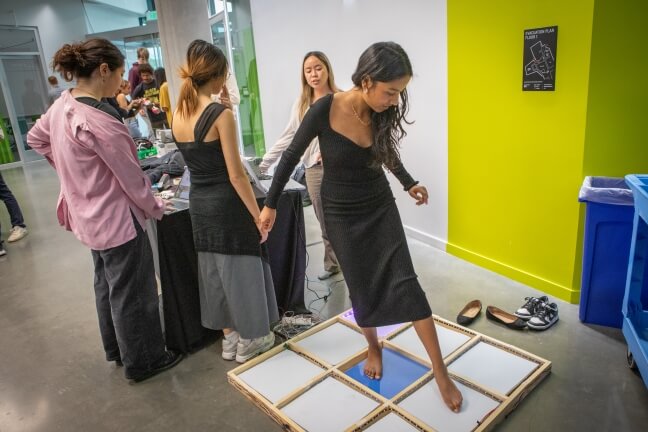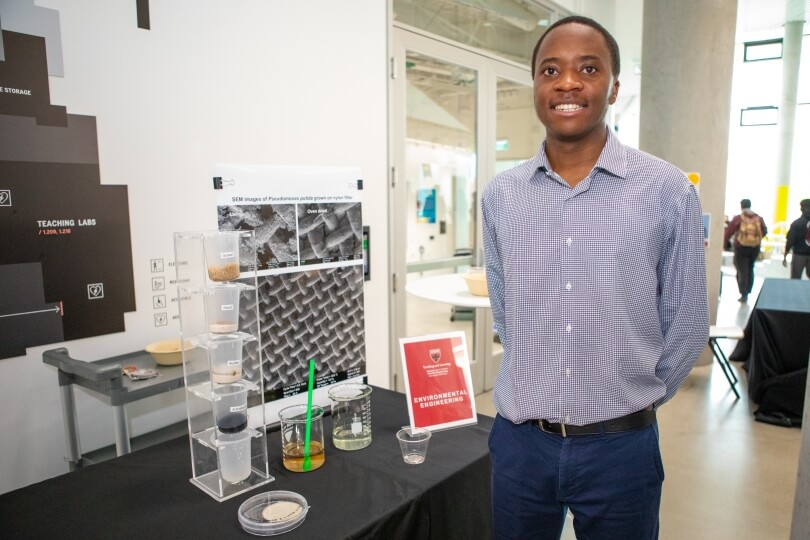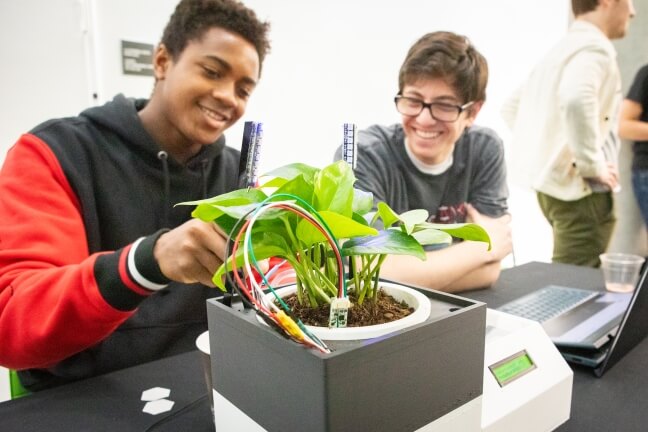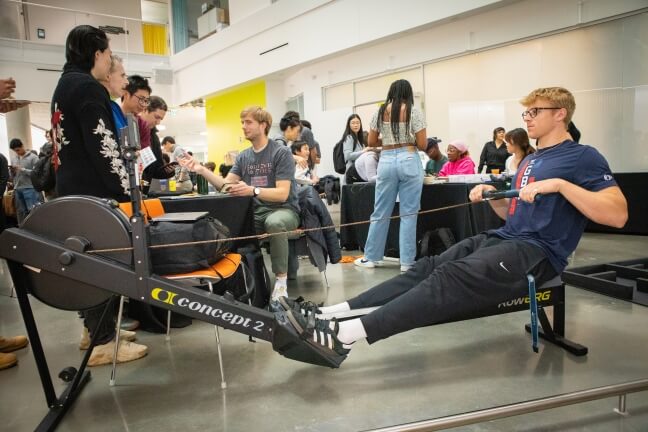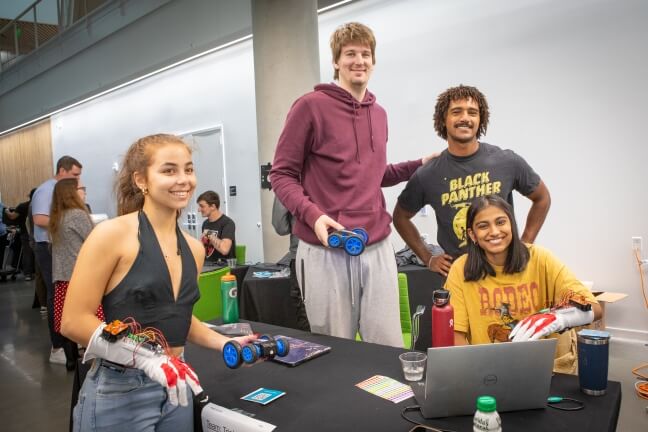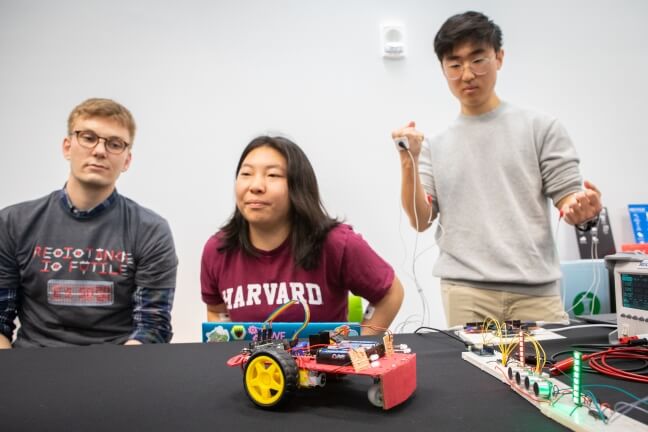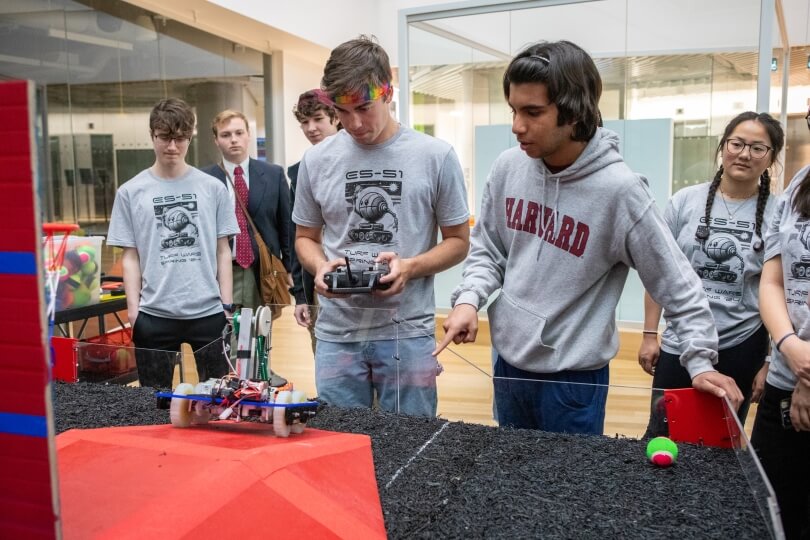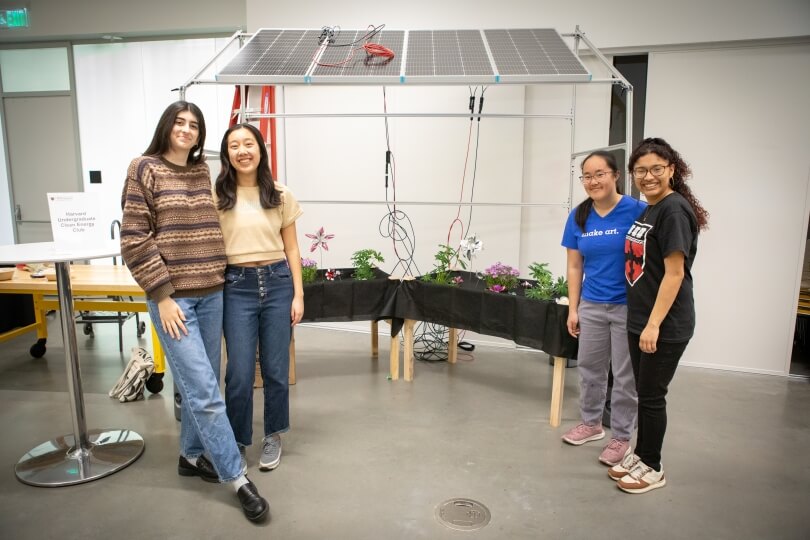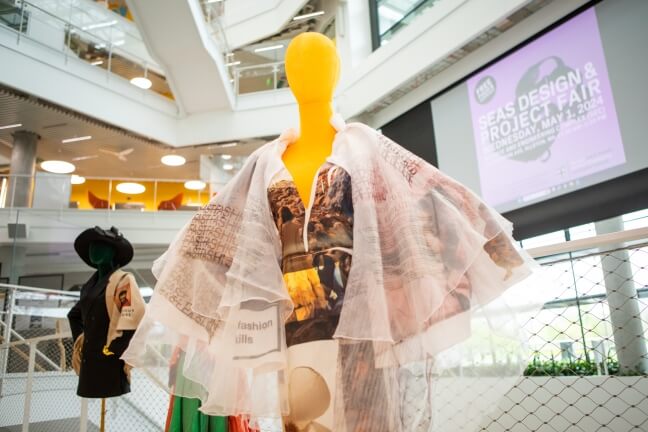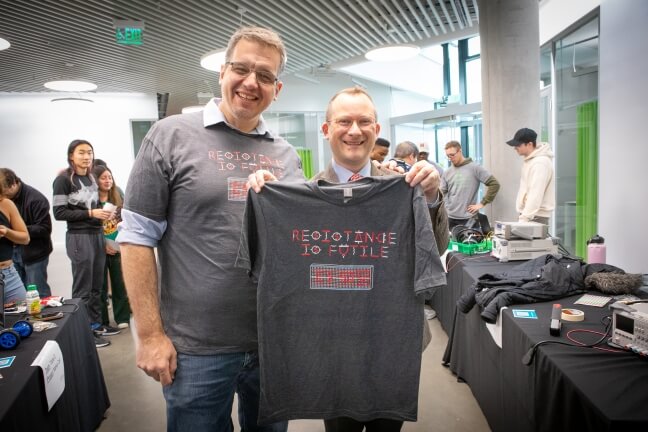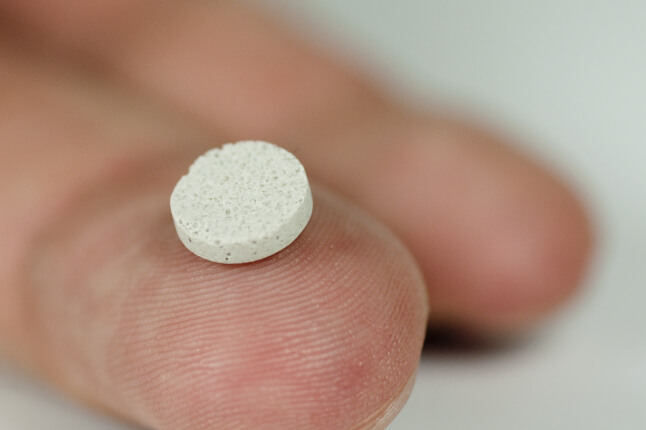News
David Dias and Daniel Villafuerte are skiers, so they designed embedded sensors for ski helmets to track temperature, ultraviolet radiation, acceleration down the slopes, and even location in case of a crash. Jen Nguyen, Dhriti Vadlakonda and Hannah Nguyen love to dance, so they built a game in which dancers had to step on lit-up tiles. Owen Marcovitz, Josh Brangan, and Benjamin Zeisberg are all on the Harvard rowing team, so they built a wireless sensor to track how fast rowers accelerate the moving seats in their boats.
“You look at the world a little bit differently once you realize how applicable something you build is,” Dias said. “It’s not just magic how this happens. It’s code. It’s components. Electrical engineering classes allow you to have the creative freedom to see how the rest of the world works.”
SkiGuard, by David Dias and Daniel Villafuerte (Eliza Grinnell/SEAS)
Dhriti Vadlakonda demonstrates the Glow Grid, co-designed with Jen Nguyen and Hannah Nguyen (Eliza Grinnell/SEAS)
As the Design and Project Fair at the Science and Engineering Complex (SEC) showed, students at the Harvard John A. Paulson School of Engineering and Applied Sciences (SEAS) bring all sorts of backgrounds and interests with them to the classroom, and find ways to build on them through the lens of engineering.
Cherish Jongwe comes from Zimbabwe, where many communities rely on untreated water from rivers for household use, so for a senior capstone project he built a filtration system incorporating bacteria to enhance removal of toxic heavy metal pollutants from water.
Cherish Jongwe with his senior capstone project, a biofiltration system to remove heavy metal pollutants from water (Eliza Grinnell/SEAS)
“There are a lot of intellectual resources at SEAS, a lot of highly intellectual people, so there’s a really great cross-pollination of ideas,” Jongwe said. “It keeps your mind thinking about what I can do to help society, with the infrastructure to actually do it.”
The SEAS Design and Project Fair brought together independent research, class final projects and extracurricular student organizations to highlight the true range of the SEAS student body. The SEC West Atrium played host to the final projects for “ES50: Introduction to Electrical Engineering.” Students danced on tile grids, piloted remote-control vehicles with muscle sensors or remote-controlled gloves, and even watched a plant box track its own temperature and hydration. The setting felt as much like a carnival as an academic showcase.
Ali Saffarini co-designed the Autonomous Plant Caretaker.
“Our circuit is used as a soil sensor that detects the temperature and moisture of the soil, and we use that to help decide if we want to power the pump to water the plant. If it’s under a certain threshold, our pump would turn on,” he said. “You power it and leave, and it’ll take care of your plant for as long as you need it.”
Added project partner Desmond Herzfelder, “I have a lot of friends whose plants have died in their rooms. I’ve tried to keep track of plants, but they’ve also died. This is a fun, relatable project for college kids.”
The Autonomous Plant Caretaker co-designed by Ali Saffarini and Desmond Herzfelder. (Eliza Grinnell/SEAS)
Josh Brangan demonstrates the Rowing Sensor, co-designed with Owen Marcovitz and Benjamin Zeisberg (Eliza Grinnell/SEAS)
The rowers in ES50 designed sensors to help track that forward seat acceleration, with the goal of helping all the rowers in the boat move together with as little forward acceleration as possible. Less forward acceleration by the seats mean less drag on the forward speed of the boat.
“We have a live feedback graph where you can see the acceleration of the seats, so the idea is to link them all up and get them looking as similar as possible,” said Brangan, a second-year mechanical engineering student.
Teammate Marcovitz added, “Once you take a class like this, you start to see it everywhere. You start to understand how people actually conceive the machines that control the world.”
Marko Kart, by Tessa Shahbo, Matt Filipowski, Smriti Somasundaram and Alex Klein Wassink (Eliza Grinnell/SEAS)
Lightning McMuscle, by Frederik Willumsen Haug, Quinlyn Long and Dennis Kim (Eliza Grinnell/SEAS)
Design Fair visitors who wanted to drive cars had two options to choose from. Frederik Willumsen Haug, Quinlyn Long and Dennis Kim built Lightning McMuscles, a literal muscle car which uses wires connected to muscle sensors on the arm. When muscles flex, the car accelerates. Marko Kart, by Tessa Shahbo, Matt Filipowski, Smriti Somasundaram and Alex Klein Wassink, used a specially designed glove, which sent different movement instructions to the car based on which fingers were pressed together.
“I’m personally doing a subtrack in electrical engineering within bioengineering, so I was interested in learning more about electrical engineering in general,” Long said. “There are a lot of intersections of engineering, so it’s really helpful to learn more. It was really cool to see multiple classes and knowledge bases come together.
Driver Jack Anderson and teammate Abdullah Shahid Sial maneuver their way to victory at Turf Wars (Eliza Grinnell/SEAS)
Students in "ESE161: Applied Environmental Toxicology" presented videos about the elimination of toxic chemicals in Harvard's building products. Check out some of there videos here.
While ES50 dominated the West Atrium, the East Atrium belonged to fourth-year students and their capstone projects. All engineering students on an S.B. track must complete a year-long research project, and a handful of A.B. students chose to do one as well. The Design Fair was their chance to celebrate the culmination of months of research, share their experiments with friends and family, and in some cases get recognized with a Dean’s Award for Outstanding Engineering Projects later that afternoon.
Downstairs in the lowest level atrium, robots clashed in Turf Wars, the final project for “ES51: Computer-Aided Design.” Turf Wars teams are tasked with building small robots capable of performing specific tasks, then face off in a series of head-to-head matchups in which the team that scores the most points wins.
This semester’s turf wars challenged teams to build robots that could grab tennis balls or hockey pucks, drive up a ramp, then drop them through a miniature basketball hoop. Driven by second-year Jack Anderson, Rohan’s Robo Warrior used a claw grabber to pick up hockey pucks, worth twice as many points as tennis balls, and drop them through hoop after hoop en route to the championship. After winning, Anderson celebrated with teammates Abdullah Shahid Sial, Michael Maines and Taylor Folk.
PHOTOXSYNTHESIS, a project is led by Lucy Nathwani, Anya Zhang Ida Chen, Ellen Caraballo, Justin Curcio, Ethan Kiang and Nancy Lin.
“We wanted to just keep it simple. The less things that are moving, the less things that can break,” said Anderson. “I love project-based courses. Engineering can sometimes feel a little monotonous, like you’re just looking at pages all day. It’s nice to have a real product that you build.”
Several student organizations were also present at the Design Fair, including the Rocket Propulsion Group
from Harvard College Students for the Exploration and Development of Space, the Harvard Undergraduate Clean Energy Group (HUCEG), and the Conflux art-tech collective. HUCEG and Conflux have been collaborating on a project called PHOTOXSYNTHESIS, an agrovoltaic set-up which will use solar panels to power spinning flowers made from recycled materials, which will be placed alongside actual plants. The project is led by Lucy Nathwani, Anya Zhang Ida Chen, Ellen Caraballo, Justin Curcio, Ethan Kiang and Nancy Lin, and is planned for installation at the SEC next year.
“I’ve been involved with HUCEG since I started in college,” said Nathwani, a second-year physics concentrator. “I’ve always been really interested in clean tech. I love the idea of using urban agrovoltaics for both ecological restoration and practical energy generation, and I thought this was a really creative way to gain hands-on experience.”
A design from FASHIONFLARE, a revolutionary fashion show that showcased the potential collaboration of human creativity and artificial intelligence. Designs were created in the REEF Makerspace using of repurposed, fair trade or sustainably harvested materials. (Eliza Grinnell/SEAS)
Professor Marko Loncar (left) and Dean David Parkes (right) pose with an ES50 shirt during their visit to the 2024 Design and Project Fair (Eliza Grinnell/SEAS)
Topics: Academics, Active Learning Labs, REEF Makerspace, Allston Campus, Bioengineering, Design, Electrical Engineering, Environmental Science & Engineering, Materials Science & Mechanical Engineering, Robotics, Student Organizations
Cutting-edge science delivered direct to your inbox.
Join the Harvard SEAS mailing list.
Press Contact
Matt Goisman | mgoisman@g.harvard.edu

